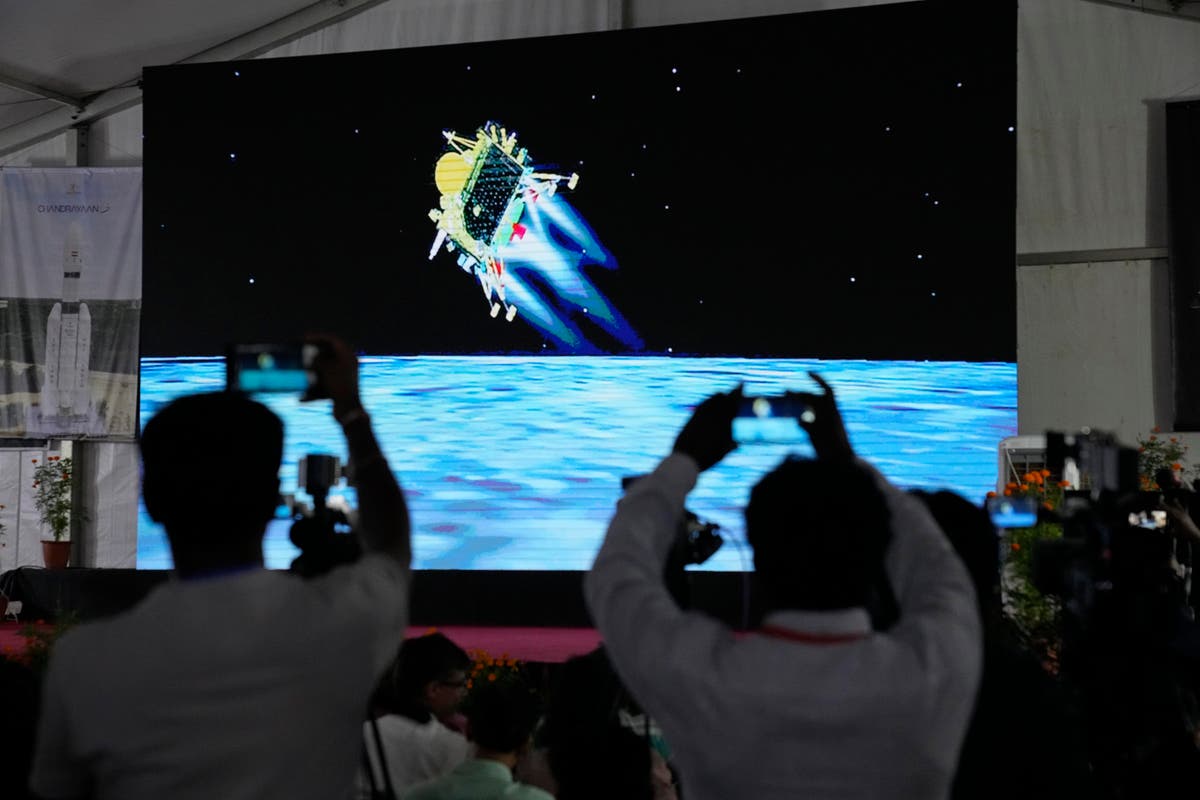India has successfully landed near the Moon’s uncharted south pole, in a historic and unprecedented feat.
The country’s Chandrayaan-3 lander completed a “soft landing” on the lunar surface. It will now spend two weeks examining the composition of the Moon near its south pole – though it has already achieved its primary mission.
It becomes the first space agency to successfully land near the region, after the Russian space agency attempted – and failed – to do so on Monday. That Luna-25 craft crashed into the lunar surface and was destroyed.
:: Follow The Independent’s live coverage of the launch here.
Indian space agency Isro successfully managed the mission just a few days later, becoming only the fourth country to soft land a probe on the Moon, after a run of failures by competitors, and a crash when India attempted to land in 2019. Only the US, the former Soviet Union and China have landed there.
“India is now on the Moon,” said Narendra Modi, who addressed Isro staff members immediately after the successful landing was announced. “On this joyous occasion, I would like to address all the people of the world, the people of every country and region: India’s successful Moon mission is not just India’s alone.”
Modi said that the work would be done in a “human-centric spirit” and urged co-operation between nations to explore the “Moon and beyond”. “This success belongs to all of humanity, and it will help Moon missions by other countries in the future,” he said.
The Moon’s south pole is expected to become a key and contested region in the years to come. Research has shown that there is water ice waiting there – which could be important for allowing humans to live on the lunar surface.
If the Chandrayaan-3 mission’s Pragyan rover manages to find water ice on the lunar surface, it could begin a rush to use it as a resource to help extract fuel and oxygen from the Moon.
Further detection and estimation of water ice on the lunar surface could raise hopes for longer-term human presence on the Moon, and facilite future missions to explore other planets in the Solar System.
Chandrayaan-3 has so far endured a long journey to the Moon, blasting off on 14 July aboard the LVM3 rocket from India’s main spaceport, Sriharikota, in the southern state of Andhra Pradesh.
“14 July 2023 will always be etched in golden letters as far as India’s space sector is concerned… This remarkable mission will carry the hopes and dreams of our nation,” Indian prime minister Narendra Modi tweeted ahead of the launch.
The mission is set to conduct science experiments on the lunar surface, whose cost comes to about £63m ($82m).
Instruments aboard the lander include a probe to measure the Moon’s surface thermal properties, called the Chandra’s Surface Thermophysical Experiment (ChaSTE), and one dubbed ILSA for measuring lunar seismic activity.
Apart from conducting ranging studies and analysing the gas and plasma environment of the Moon, the mission is also expected to bring more investment to India’s growing number of space startups and institutes.
Russia’s space agency chief Yury Borisov said in an interview earlier this week that Moon missions are “not just about the prestige of the country” but also of “practical value,” adding that “the race for the development of the natural resources of the moon has begun.”
“In the future, the moon will become a platform for deep space exploration, an ideal platform,” he said.
Nasa administrator Bill Nelson also said earlier this year that the US is in a new space race, hinting at the country’s technological competition with China.
“It is a fact, we’re in a space race,” Mr Nelson told Politico.

